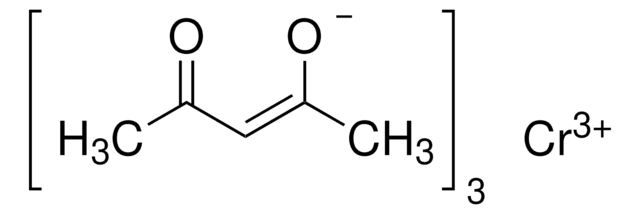238538
Cerium(III) nitrate hexahydrate
99% trace metals basis
Synonyme(s) :
Cerium trinitrate, Cerous nitrate hexahydrate, Nitric acid cerium salt
About This Item
Produits recommandés
Niveau de qualité
Pureté
99% trace metals basis
Forme
crystals and lumps
Pertinence de la réaction
reagent type: catalyst
core: cerium
Impuretés
1-2% La
Chaîne SMILES
[Ce+3].[H]O[H].[H]O[H].[H]O[H].[H]O[H].[H]O[H].[H]O[H].[O-][N+]([O-])=O.[O-][N+]([O-])=O.[O-][N+]([O-])=O
InChI
1S/Ce.3NO3.6H2O/c;3*2-1(3)4;;;;;;/h;;;;6*1H2/q+3;3*-1;;;;;;
Clé InChI
QQZMWMKOWKGPQY-UHFFFAOYSA-N
Vous recherchez des produits similaires ? Visite Guide de comparaison des produits
Description générale
Application
Ceria is one of the best studied materials-platforms for catalysis and solid oxide fuel cells. Consequently scientists have developed well-controlled synthetic protocols using cerium (III) nitrate hexahydrate for preparing ceria nanoparticles including nano cubes, nanotubes, and nanorods. The tailorable synthesis facilitates using ceria as a catalyst support, for example leveraging the porosity of the microstructure to impregnate metals and metal alloys, or for example synthesizing ceria-based materials like ceria-zirconia.
Mention d'avertissement
Danger
Mentions de danger
Conseils de prudence
Classification des risques
Aquatic Acute 1 - Aquatic Chronic 1 - Eye Dam. 1
Code de la classe de stockage
5.1B - Oxidizing hazardous materials
Classe de danger pour l'eau (WGK)
WGK 2
Point d'éclair (°F)
Not applicable
Point d'éclair (°C)
Not applicable
Équipement de protection individuelle
Eyeshields, Gloves, type P3 (EN 143) respirator cartridges
Faites votre choix parmi les versions les plus récentes :
Certificats d'analyse (COA)
Vous ne trouvez pas la bonne version ?
Si vous avez besoin d'une version particulière, vous pouvez rechercher un certificat spécifique par le numéro de lot.
Déjà en possession de ce produit ?
Retrouvez la documentation relative aux produits que vous avez récemment achetés dans la Bibliothèque de documents.
Les clients ont également consulté
Articles
The rare earth elements impact nearly everyone in the world. All of the people living in advanced technological countries and almost all those living in third world countries utilize the rare earths in their everyday living—the car that one drives (gasoline is refined from oil using rare earth catalysts and catalytic converters reduce the polluting emissions from the automotive exhaust), watching the news on TV (the red and green colors in TV screens), the telephones and computers we use to communicate (the permanent magnets in speakers and disc drives), just to name a few examples.
Notre équipe de scientifiques dispose d'une expérience dans tous les secteurs de la recherche, notamment en sciences de la vie, science des matériaux, synthèse chimique, chromatographie, analyse et dans de nombreux autres domaines..
Contacter notre Service technique














